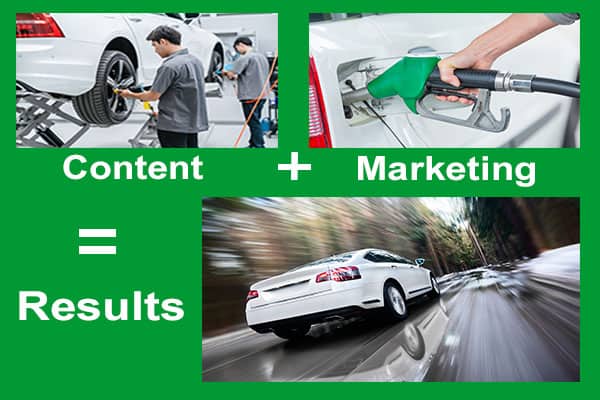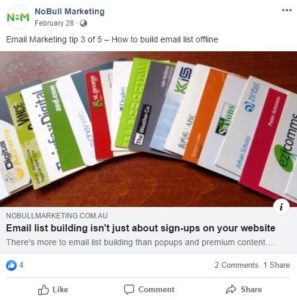Common issues with small business content marketing
Some businesses write blogs that no one ever reads. Some businesses concentrate on social media instead. They push out lots of micro content pieces and build a following. But there are problems with this model too.
- Even if you build a follower base successfully, you don’t own those followers or have their contact details.
- You can’t guarantee that followers see future content on the platform – unless you pay! Check how organic social media is distributed in this recent post.
- The content gets lost in the feed. It’s not easily available for people who come by later.
- It’s hard to steer people from one piece of content to the next as they grow more interested.
The challenge is to create good content, collect it in one place (your website!), then promote the heck out of it so that people know about it and engage with it.
So what does good content marketing look like?
Content marketing is half about the content and half about the marketing.
Some would argue it’s more than half about the marketing. From search engine optimisation to social media to general promotion opportunities, there’s a lot you need to do to get your content out there and make your content marketing work. Without the promotion, your content just sits there like a car with an empty gas tank. Nothing happens. You go nowhere.  There are three core areas you need to include in all content marketing, plus some additional options which may apply. (We’ve included them all on our checklist.) 3 out of 4 areas are about content promotion. That’s how important it is! (And everything we list below is included on our handy content promotion checklist, so you can get it right every time!)
There are three core areas you need to include in all content marketing, plus some additional options which may apply. (We’ve included them all on our checklist.) 3 out of 4 areas are about content promotion. That’s how important it is! (And everything we list below is included on our handy content promotion checklist, so you can get it right every time!)
1. Creating quality content on your website
First of all you want your content on your website. Whether it’s a blog, a collection of resource or a gallery of projects you have completed, you want it on your website. Why?
-
- You own your website and all the content on it. No one else can change the rules or make your content less visible.
- The content builds your website SEO. Every extra page means you can optimize for more keywords. (Make sure you get your on-page optimisation right too!)
- Fresh content added to your site also helps Google see it as fresh and up to date
- You can (if you’re clever) use links and calls to action to move visitors closer to becoming customers. So general information content can link to an industry-specific case study, or to a service page describing what you do and how it benefits clients. These pages then have a call to action to make an enquiry.
But let’s face it, there’s a problem. Most of your target market are not visiting your website regularly. That’s where the marketing part of content marketing comes in.
2. Promoting your content on social media
Social media should be part of every content marketing plan or process. Posting on social media puts your content where people actually are. It’s the difference between standing in the corner at a party versus going up and joining group who are chatting already. If you just wait for people to approach you, the only ones who do are trying to sell you something. Think of all those contacts from the website trying to sell you on SEO services, explainer videos or Russian dating sites. That’s what happens if you don’t go out and get involved. But when you post on social media, beware of taking over the conversation. This is the time for networking chat, not a hard sell. For a meaty blog post, your best option is to pick a snippet to share, then wait to see who shows interest. You can have multiple short and snappy bits of content per post or per project, of course!  Small, snackable posts linking to a more in-depth article on your website can drive traffic. Even the ones people ignore give you another link to your site. And if anyone shares your posts, that increases your audience too!
Small, snackable posts linking to a more in-depth article on your website can drive traffic. Even the ones people ignore give you another link to your site. And if anyone shares your posts, that increases your audience too!
3. Using your content in email marketing
Once you’ve created content, you should also share with your contact database – or at least a segment of your database. Why? These people have expressed interest in you and your services already. But they’re not hanging on the edge of their seats waiting to see what you publish on your blog or post on social media. If you want to maintain or build the relationship, you need to reach out proactively. Email marketing has a higher response rate by far than any social media. Unsurprising, since these people have shared their contact details with you.
Additional options on the content promotion checklist
While the three areas above are must-haves for every piece of content. Our checklist also includes some other options which may or may not work for you. Here they are.
Reach out to anyone involved in the content piece you created
The law of recipricocity says that if you do something good for others, they’ll want to help you too. Use this to help promote your content. Send a link to your project or case study to the client and any partners you worked with, with a personal note thanking them. Of course your content says nice things about them. So why wouldn’t they share? What if you’ve interviewed other business owners or shared positive information about suppliers or software providers? Same thing. They’re likely to share any positive mentions because it makes them feel good. If you did research for a piece of content, you might even end up quoting a person or company you don’t even know. Try reaching out and thanking them for the information which helped you with your article – and include a link. If you do this on social media, you have the option to tag them or to post to their feed. Both are ways to reach their audience. But if you can persuade them to share or comment positively, this will have a much greater impact.
Engage with other related content
Someone somewhere has already created content closely related to yours. If your piece adds something to the conversation, there’s an opportunity to share.
- Sometimes you can comment on blogs.
- Discussion boards are great.
- Sometimes (if you’re really adding value) you can reach out to the owner of the website explaining why a link in their article would be good.
Unfortunately there’s no quick way to find discussion forums and blogs you can comment on any more.
- The closest I have found is a Chrome extension which tries to replicate Google’s deprecated discussion board algorithm. It’s not perfect, but about half the results I tested had an opportunity to comment.
- Also search Reddit. There’s a board for just about anything. But make sure you follow rules and don’t spam!
LinkedIn articles
LinkedIn is a funny beast. Company pages exist, but all the action is on personal profiles. So if you’re active on LinkedIn, why not publish articles? Posts drop down the newsfeed. Articles stay visible on your profile forever. (Or until LinkedIn change the way profiles work.) They are a great way to showcase your expertise for anyone and everyone who visits your profile.  If you decide to publish LinkedIn articles, try waiting a week or two before you do it. Also consider including a link to the original content on your website at the end of your article. This helps Google to see your website as the original home of the content. LinkedIn doesn’t need any help showing up in search results – you might!
If you decide to publish LinkedIn articles, try waiting a week or two before you do it. Also consider including a link to the original content on your website at the end of your article. This helps Google to see your website as the original home of the content. LinkedIn doesn’t need any help showing up in search results – you might!
How much marketing do you do in your content marketing? More importantly, how much are you going to do in the future? There are three options:
- Carry on as you are. Just don’t expect your content marketing results to get better!
- Download our content promotion checklist so you can promote your content more effectively.
- If that sounds like too much work, try one of our content marketing packages and let us do the heavy lifting for you.





